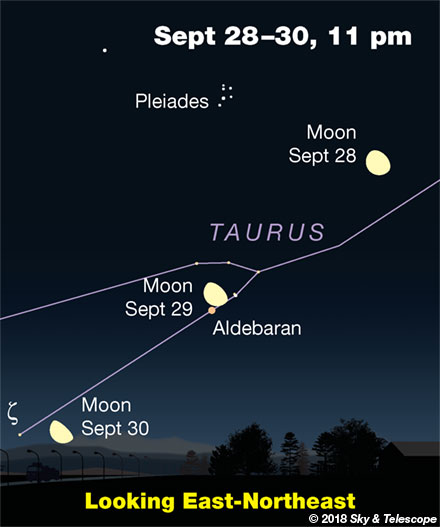
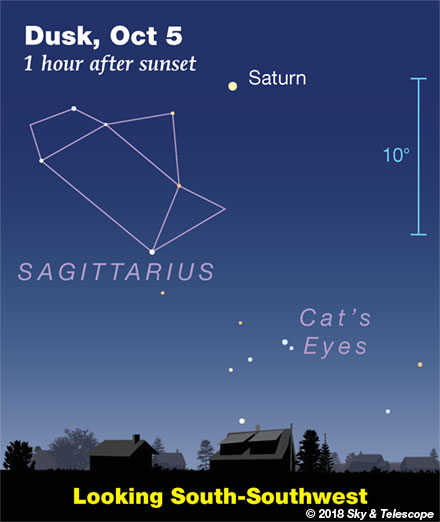
Friday, September 28
• Late this evening, spot the little Pleiades cluster to the upper left of the Moon, as shown at right. When we see the Pleiades climb the eastern sky in autumn, their tiny dipper pattern stands on its handle.
Saturday, September 29
• There's roughly a two-hour window of darkness now between twilight's end and moonrise (for the world's mid-northern latitudes). The window gets longer every night this week. Take the opportunity to work through Jerry Oltion's "Tourist Guide to the Autumn Highlights" for small scopes in the October Sky & Telescope, page 28.
• Late tonight when the Moon does rise, it's in company with Aldebaran — though not necessarily quite as shown here. Remember, in these scenes the Moon is always shown three times its actual apparent size, and it's positioned for an observer near the middle of North America (exact for latitude 40° north, longitude 90° west).
By Sunday morning the 30th, the Moon and Aldebaran are shining very high toward the south.
Sunday, September 30
• Algol in Perseus, the prototype eclipsing variable star, should be at its minimum brightness, magnitude 3.4 instead of its usual 2.1, for a couple hours centered on 8:58 p.m. Eastern Daylight Time, when Perseus is in good view from the Eastern time zone well up in the northeast. Algol takes several hours to fade beforehand and to rebrighten after. Comparison-star chart.
Monday, October 1
• The starry W of Cassiopeia stands high in the northeast after dark. The right-hand side of the W (the brightest side) is tilted up. Look along the second segment of the W counting down from the top. It's not quite horizontal. Notice the dim naked-eye stars along that segment (not counting its two ends). The brightest of these, on the right, is Eta Cassiopeiae, magnitude 3.4, a Sun-like star just 19 light-years away with an orange-dwarf companion — a lovely binary in a telescope.
The "one" on the left, fainter, is a naked-eye pair when seen in a dark sky: Upsilon1 and Upsilon2 Cassiopeiae, 0.3° apart. They're orange giants unrelated to each other, 200 and 400 light-years distant from us. Upsilon1 is slightly fainter; that's the farther one.
Tuesday, October 2
• Last-quarter Moon (exact at 5:45 a.m. on this date). Tonight, the Moon rises around midnight or 1 a.m. in Gemini. Before dawn Wednesday morning, you'll find it shining high with Pollux and Castor to its upper left and Procyon farther to its lower right.
Wednesday, October 3
• Cygnus floats high overhead these evenings. Its brightest stars form the big Northern Cross. When you face southwest and crane your head overhead, the cross appears oriented upright. It's about two fists at arm's length tall.
The bottom star of the cross is Albireo, not very bright. It's a fine double star for 10x binoculars, but how well you can resolve it in binoculars depends on their optical quality and how steady you can brace them.
From Albireo, you can star-hop to the planetary nebula M27 and to lesser-known Stock 1, a very large but sparse star cluster, using Matt Wedel's Binocular Highlight column and chart in the October Sky & Telescope, page 43.
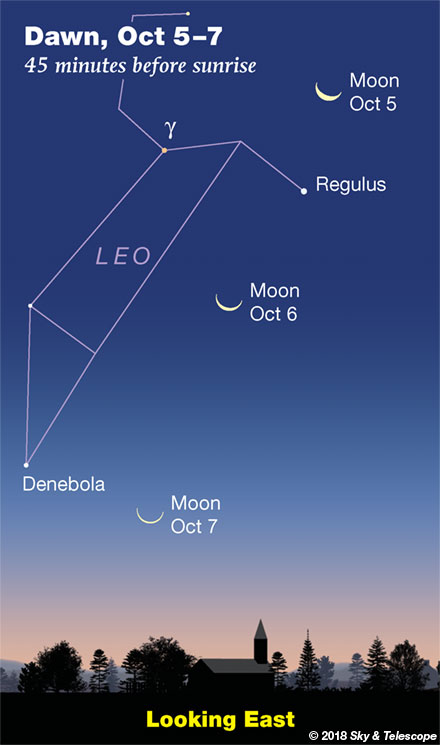
Thursday, October 4
• After dark, look just above the northeast horizon — far below high Cassiopeia — for bright Capella on the rise. How soon Capella rises, and how high you'll find it, depends on your latitude. The farther north you are, the sooner and higher.
Friday, October 5
• These evenings the Great Square of Pegasus stands high in the east, still tipped onto one corner. It's a little larger than your fist held at arm's length.
From its left corner runs the line of three similarly bright stars marking the main line of Andromeda.
As evening grows late, the Square's upper-right side points far down to Fomalhaut on the rise (four or five fists distant).
Saturday, October 6
• Vega is the brightest star very high in the west right after nightfall. Arcturus, equally bright, is getting low in the west-northwest. The brightest star in the vast expanse between them, about a third of the way from Arcturus up toward Vega, is Alphecca, magnitude 2.2 — the crown jewel of Corona Borealis. Alphecca is a 17-day eclipsing binary, but its brightness dips are too slight for the eye to see reliably.
________________________
Want to become a better astronomer? Learn your way around the constellations! They're the key to locating everything fainter and deeper to hunt with binoculars or a telescope.
This is an outdoor nature hobby. For an easy-to-use constellation guide covering the whole evening sky, use the big monthly map in the center of each issue of Sky & Telescope, the essential guide to astronomy.

Once you get a telescope, to put it to good use you'll need a detailed, large-scale sky atlas (set of charts). The basic standard is the Pocket Sky Atlas (in either the original or Jumbo Edition), which shows stars to magnitude 7.6.
Next up is the larger and deeper Sky Atlas 2000.0, plotting stars to magnitude 8.5; nearly three times as many. The next up, once you know your way around, are the even larger Interstellarum atlas (stars to magnitude 9.5) and Uranometria 2000.0 (stars to magnitude 9.75). And read how to use sky charts with a telescope.
You'll also want a good deep-sky guidebook, such as Sue French's Deep-Sky Wonders collection (which includes its own charts), Sky Atlas 2000.0 Companion by Strong and Sinnott, or the bigger Night Sky Observer's Guide by Kepple and Sanner.
Can a computerized telescope replace charts? Not for beginners, I don't think, and not on mounts and tripods that are less than top-quality mechanically (meaning heavy and expensive). And as Terence Dickinson and Alan Dyer say in their Backyard Astronomer's Guide, "A full appreciation of the universe cannot come without developing the skills to find things in the sky and understanding how the sky works. This knowledge comes only by spending time under the stars with star maps in hand."
This Week's Planet Roundup
Mercury is hidden in the glare of the Sun.
Venus (magnitude –4.8, still at its peak brilliancy) shines very low in the west-southwest after sunset and sets in mid-twilight. Don't confuse it with Jupiter, which will catch your eye first. Venus is 14° to Jupiter's lower right.
In a telescope Venus is an increasingly striking crescent, enlarging as it approaches Earth. It's now about 20% sunlit and 46 arcseconds tall. For better telescopic seeing, catch Venus higher in a blue sky long before sunset.
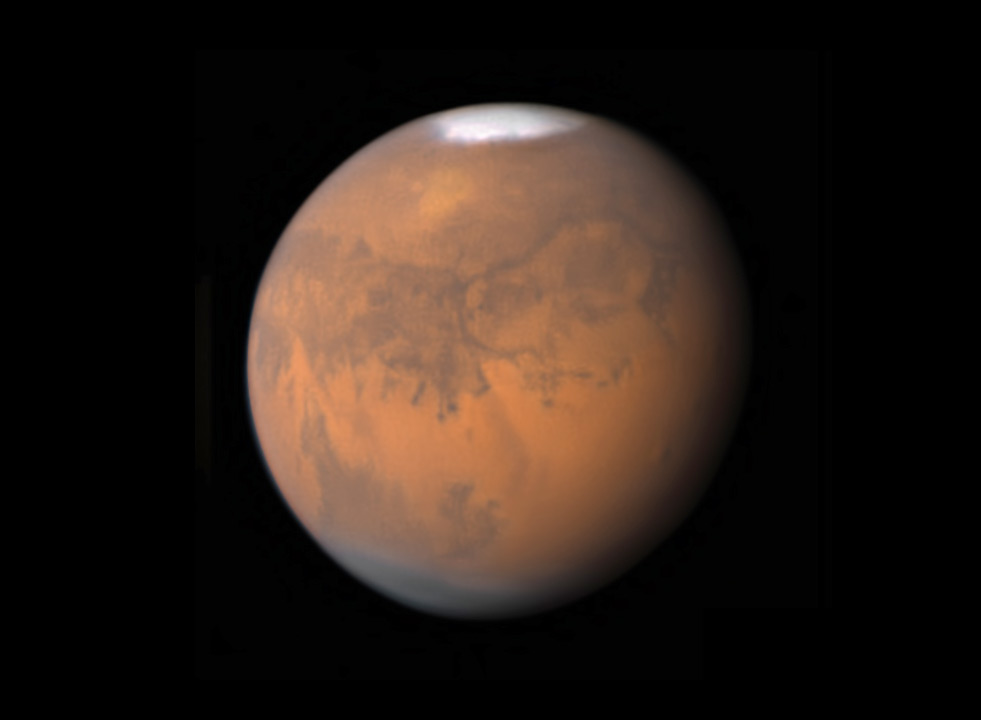
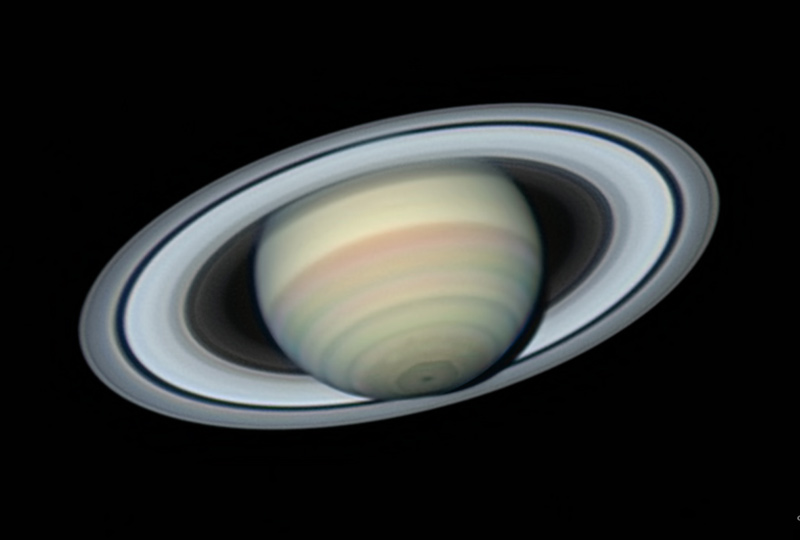
Mars, in southern Capricornus, fades from magnitude –1.3 to –1.1 this week. It shines highest in the south soon after dark and sets around 1 or 2 a.m.
In a telescope Mars shrinks from 16 to 15 arcseconds wide. For a Mars map that displays which side is facing Earth at your time and date, use our Mars Profiler.
Jupiter (magnitude –1.8, in Libra) shines ever lower in the southwest in twilight, 14° upper left of very low Venus.
Saturn (magnitude +0.5, above the spout-tip of the Sagittarius Teapot) glows pale yellow in the south-southwest at dusk, getting low. It's three or four fists at arm's length to the lower right of brighter Mars.
Uranus, near the Aries-Pisces border, is easy in binoculars at magnitude 5.7 — if you have a finder chart and know the constellations well enough to see where to start with it.
Neptune, in Aquarius, is harder at magnitude 7.8. By late evening both are well up in the east and southeast, respectively. Finder charts for Uranus and Neptune, or see the September Sky & Telescope, page 48.
______________________
All descriptions that relate to your horizon — including the words up, down, right, and left — are written for the world's mid-northern latitudes. Descriptions that also depend on longitude (mainly Moon positions) are for North America.
Eastern Daylight Time (EDT) is Universal Time (also called UT, UTC, GMT, or Z time) minus 4 hours.
______________________
"Remember to look up at the stars and not down at your feet. Try to make sense of what you see and wonder about what makes the universe exist. Be curious."
— Stephen Hawking, 1942–2018
______________________
"The dangers of not thinking clearly are much greater now than ever before. It's not that there's something new in our way of thinking, it's that credulous and confused thinking can be much more lethal in ways it was never before."
— Carl Sagan, 1996
______________________
"Objective reality exists. Facts are often determinable. Vaccines save lives. Carbon dioxide warms the globe. Bacteria evolve to thwart antibiotics, because evolution. Science and reason are not a liberal conspiracy. They are how we determine facts. Civilization's survival depends on our ability, and willingness, to do this."
— Alan MacRobert, your Sky at a Glance editor
______________________
"Facts are stubborn things."
— John Adams, 1770
 3
3








Comments
misha17
September 28, 2018 at 4:31 pm
For residents in the southern states, this is the start of Canopus viewing season. Canopus is so low in the sky that it can only be seen as it crosses the meridian just above the southern horizon. This week Canopus is due south around 6:30am Daylight Time, just before the morning twilight sky gets too bright.
Canopus crosses the meridian about 4 minutes earlier each morning; combined with the sunrise (and morning Twilight) occurring a few minutes later each day, Canopus will be visible in a dark pre-dawn sky by next week.
You must be logged in to post a comment.
misha17
September 28, 2018 at 4:37 pm
If you've never seen Canopus before, look for Mirzam (β Canis Majoris) the bright star to the right of Sirius. When Mirzam is due south, look straight down (South) for Canopus just above the horizon.
Mirzam (and Canopus) cross the meridian about 20 minutes before Sirius does.
You must be logged in to post a comment.
Rod
September 28, 2018 at 11:16 pm
FYI, I viewed tonight from Patuxent river valley farms in Maryland. Lately in my area, much clouds and rain, now clearing up and getting cooler for the fall season. I enjoyed some good views of Mars and Saturn tonight using my 90-mm refractor. Mars at 200x and lower power views was distinct gibbous shape with nearly 89% illuminated and 16 arcsecond size along with surface features (Syrtis Major area near central meridian of 220 degrees when I viewed). Saturn was fun and using 10x50 binoculars, I could see Saturn and M8 in same field of view. Also M20 too. Scattered cirrus clouds in the area. I plan to use my 10-inch telescope in October for some views of M31. Looking forward to those observations.
You must be logged in to post a comment.
You must be logged in to post a comment.